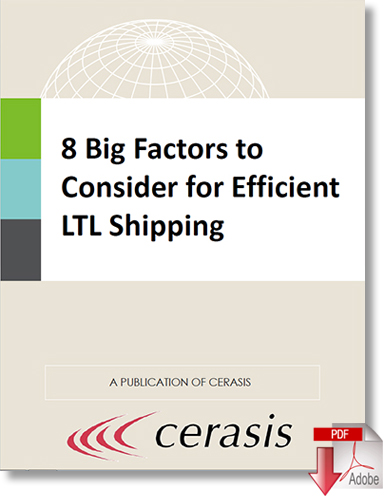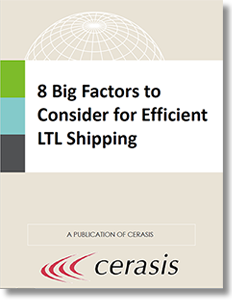LTL DIM Pricing: Why Less-Than-Truckload Is Moving to Dimensional Based Pricing

Unfortunately, the use of Less-Than-Truckload DIM pricing is often overlooked for a simple reason; DIM pricing is usually associated with overnight shipping and parcels, not LTL.
LTL DIM Pricing
The use of dimensional (DIM) pricing has an extensive history by the Big Three carriers.
FedEx, UPS, and DHL all claim to have been the first to switch to DIM pricing in 2013, but all packages were swapped over into the DIM pricing model in 2015.
The United States Parcel Service was among the last carriers to make the switch.
Unfortunately, the use of LTL DIM pricing is often overlooked for a simple reason; DIM pricing is usually associated with overnight shipping and parcels, not LTL, explains Satish Jindel via JOC.com.
In reality, the current rates and practices in determining the shipping cost for LTL carriers are unsustainable.
As a result, shippers need to understand a few things about the problems leading to this switch, how it can fix a broken rating system and how to leverage DIM pricing knowledge to maintain control over freight spend.
The Problem with Traditional Freight Classification Rates
Freight classes have been primarily defined by an era that is far out of touch to today’s marketplace.
Freight classes were determined by the National Motor Freight Classification (NMFC) in 1935, as noted by Jack Ampuja via Medium, and with the passage of the Motor Carrier Act, freight rates were determined based on freight characteristics, including:
- Value of the product and susceptibility to damage.
- Handling characteristics.
- Stowability characteristics.
This system rated freight based on the product itself, not necessarily packaging.
In 16 years, that system will be a century old, and it is impractical to think that the modern world of shipping can operate within such stringent boundaries.
At the same time, the variety of products and things being shipped has risen exponentially.
The entire global supply chain has opened the door to products of countless values, uniqueness, and much more. In the hopes of keeping products safe, manufactures, and shippers have turned to excessive waste of packaging.
The carrier does not control packaging; this shipper does. Unfortunately, shippers that have kept packaging limited and avoided the unnecessary bulk are effectively subsidizing those who do not.
Think about it. Shippers should pay based on the amount of space they use and how troublesome something is to move, and bulky, lightweight packages can require more attention to detail than the most massive loads.
LTL DIM Pricing Levels the Playing Field
The use of LTL DIM pricing is even higher then it’s used in full truckloads. LTL shipments are subject to combination with another shippers’ freight.
In addition, freight weights for LTL freight are within a range of almost 9900 pounds. Instead of paying for the actual weight of freight, LTL shippers should be paying for how much space and work is required to move the shipment.
It is grossly unfair for shippers that make efficient use of packaging and reduce space needed to have to pay the same traits as a package taking up ten times or more of the volume.
How to Use LTL DIM Pricing to Reduce Freight Spend
Although LTL DIM pricing is relatively new, shippers that take the time to understand DIM pricing can effectively lower their freight spend. Critical aspects of understanding DIM pricing and leveraging it to reduce spending, include:
- Understand the cost of serving shipments. The value of service for shipment refers to its handling costs and the amount of space necessary to move it. In other words, the volume consumed by a shipment affects how much it costs carriers, reports Jindel.
- Reduce wasted packaging. In addition to tapping into lower freight rates for LTL shipping, shippers that utilize DIM pricing can effectively lower the cost associated with excess packaging.
- Encourage multi-piece shipments. For shippers that do need to fill a large volume, they should wait until they have enough freight to fill the volume without unnecessary packaging. This is a focal point of overcoming the LTL deficit rating, which will discuss in the next blog post.
- Automate measuring of packages. Automation has been a godsend for shippers, and new types of technology have been developed and have decreased in price to allow shippers to measure the dimensions of freight immediately. Integration with freight scheduling and transportation management systems (TMS) can also help shippers know what to expect when the carrier determines the rate for the shipment.
- Select the LTL carrier with the higher LTL DIM pricing. In general, it is impractical to try to calculate the DIM weight of each shipment, so shippers need something else to live by. The simplest measure of which carrier will be best for shipment is to look for the carrier the lowest them pricing factor.
Putting It All Together
Comprehension of pricing models in modern freight management is essential to controlling freight spend, and while shippers using parcel have grown accustomed to dimensional pricing, the idea of LTL DIM pricing can still come off as a shock. Shippers need to know that DIM pricing will affect LTL shipments with higher prevalence in the coming year.
Fortunately, those that take the time to understand them pricing can ensure LTL freight spend does not increase unexpectedly.
Related: How High Driver Turnover in Less-Than-Truckload Carriers Impacts Shippers’ Freight Spend
Related White Papers
The State of & Pricing Outlook of the Less than Truckload Shipping Market New!
This is a must-read for shippers who are either LTL shipping pros, new LTL shippers who are needing education, or those moving more freight to the LTL mode as Full Truckload feels the capacity crunch squeeze. Download Now!
8 Big Factors to Consider for Efficient Less-than-Truckload Shipping New!
In this all-new e-book, we discuss the 8 core areas that Less-than-Truckload shippers can focus on in order to have more efficient LTL shipping practices. Download Now!
Top Supply Chain Trends that Will Impact Supply Chain Management in 2018
In this white paper, we discuss the non-technological trends supply chain managers must know and then will hone in on the technologies that will impact the supply chain in 2018. Download Now!
More Resources from Cerasis
Article Topics
Cerasis News & Resources
GlobalTranz Appoints Executive Chairman Bob Farrell as Chief Executive Officer Amazon’s Drone Delivery Hits Milestone with Federal Aviation Administration Clearance Digital Supply Chain: The Landscape, Trends, Types, and the Application in Supply Chain Management Walmart’s Bid for TikTok Could Benefit the Retail Giant’s Ecommerce and Advertising Businesses The State of Ecommerce Logistics Heading into 2020 Peak Delivery Season Bringing Omnichannel to the Forefront of Ecommerce FedEx’s Fred Smith Optimistic About Economic Recovery as Ecommerce Business Booms More CerasisLatest in Transportation
Baltimore Bridge Collapse: Impact on Freight Navigating Amazon Logistics’ Growth Shakes Up Shipping Industry in 2023 Nissan Channels Tesla With Its Latest Manufacturing Process Why are Diesel Prices Climbing Back Over $4 a Gallon? Luxury Car Brands in Limbo After Chinese Company Violates Labor Laws The Three Biggest Challenges Facing Shippers and Carriers in 2024 Supply Chain Stability Index: “Tremendous Improvement” in 2023 More Transportation


















